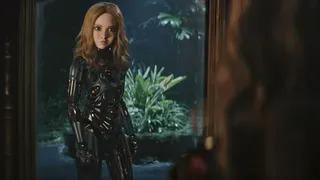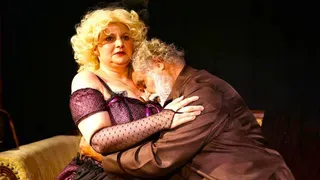September 23, 2009
Valentino - The Last Emperor
Steve Weinstein READ TIME: 3 MIN.
On the surface a portrait of one of the last of the truly legendary clothing designers, Valentino: The Last Emperor is actually a love story. A genius at putting together a woman's gown, Valentino readily admits that he is terrible at business. It was his 50-year relationship with Giancarlo Giammetti that allowed him to become a brand.
This highly enjoyable documentary shows Valentino and Giammetti at Rome's Cafe de Paris, where they argue about how they met. The details may be hazy after all these years, but the two men can still recall the sense of "la dolce vita" that permeated Rome at that time.
With Giammetti's business acumen, Valentino was poised to take that world by storm. The film alludes to his most famous outfit, the wedding dress worn by Jacqueline Kennedy when she wed Aristotle Onasis. That sent his name into orbit, and Valentino became, with St. Laurent, Cardin and one or two others, the most important and wealthiest couturier in the world.
Although they are no longer lovers, they remain joined at the hip. Gaimmetti claims that in 50 years, there was a total of two months, tops, that they were separated. Their relationship is like "La Cage Aux Folles" with a lot more money, fame and glamor: Valentino is the temperamental star entertainer; Giammetti the rational one who irons out all of life's creases.
Director Matt Tyrnauer was granted extraordinary access to the two men's world for three years, and the result is a revealing look at an opulent life that makes "Dynasty" look like "Tobacco Road" (appropriately, Joan Collins reappears from time to time, like a road marker of wretched excess).
Tyrnauer must have had a sense that he was capturing this larger-than-life talent in the twilight of his creativity; after all, he's 75 during the incredible tribute that takes over the entire central district of Rome. But the fact that Valentino retired only a few months after filming ceased makes this all the more interesting--and poignant.
Tyrnauer documents the trajectory of the corporate world's increasing involvement in Valentino's business. As the bottom line comes into play more and more, Valentino's outsized lifestyle looks less and likely to survive the "suits."
But meanwhile, what a ride! We see the private jet, the Louis XIII chalet, the Roman palazzo. We get a brief glimpse of skiing in Gstaad, where he owns a chalet. He owns so many homes, we don't even see the other Roman house or the London townhouse; the New York apartment is only glimpsed as a street awning while he gets into a waiting limo.
Fortunately, there are the DVD extras. One, "The Perfect Life," does show us his many homes. The other two, "The Last Collection" and "A Red Dress" are essentially glosses on the main feature, although they are must-viewing for anyone interested in haute couture.
Trailing him everywhere like a yapping Greek chorus is a flock of pugs. The dogs are treated with more respect and attention than the rail-thin models, the seamstresses or the many minions who tend to the fashion empire.
One could complain that, although Tyrnauer had such extraordinary access and ended up with hundreds of hours of films, there are still places where he doesn't go. Occasionally, we hear someone insist that the camera go off, and the scene switches. We don't see Valentino's current paramour.
Even so, there are a lot of shockingly frank conversations. I never got the feeling that people were acting out for the camera. Well, almost never. Anyway, these people live their lives as though a camera is trained on them whether it is not.
Valentino retired shortly after this film was completed. His successors haven't fared very well in the new world of corporate couture. It's doubtful that he would have, either--which makes this time capsule of a type of life, of design, of society, that will never return essential viewing.
Steve Weinstein has been a regular correspondent for the International Herald Tribune, the Advocate, the Village Voice and Out. He has been covering the AIDS crisis since the early '80s, when he began his career. He is the author of "The Q Guide to Fire Island" (Alyson, 2007).







